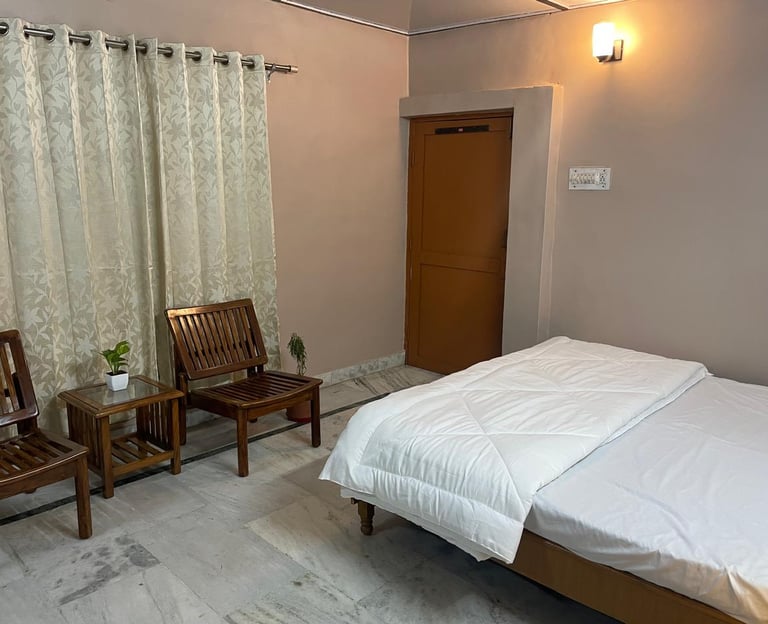St. John in the Wilderness Church in Dharamshala
Distance from The Dharamshala Nook Homestay is 10 Kilometers


St. John in the Wilderness Church, Dharamshala: A Traveller's Guide to History and Serenity
Nestled amidst the dense, whispering deodar forests between Dharamshala and McLeod Ganj, the St. John in the Wilderness Church is more than just a place of worship. It is a captivating relic of the British Raj, a testament to architectural resilience, and a sanctuary of profound peace in the Himalayan foothills.
For any visitor to the Kangra Valley, this serene Anglican church offers a perfect blend of history, architecture, and natural beauty. This guide provides you with all the essential information for your visit.
What is St. John in the Wilderness Church?
St. John in the Wilderness is a historic Protestant church dedicated to John the Baptist. It is one of the oldest structures in the Dharamshala region, built during the British Colonial era.
The name "in the Wilderness" perfectly describes its setting, surrounded by towering deodar trees that create a mystical and tranquil atmosphere, far removed from the hustle of the nearby towns.
Details:
Location: Forsyth Gunj, on the road between Dharamshala and McLeod Ganj (Near Naddi Village Road).
Dedication: St. John the Baptist
Architectural Style: Neo-Gothic (Gothic Revival)
Year Built: 1852
Entry Fee: Generally, there is no entry fee. (However, a small nominal fee has been reported by some sources post-2020. It's best to be prepared for a minor charge or to consider a donation.)
A Glimpse into the Church's History
The history of the church is intimately linked to the British presence in the region, which served as a popular summer retreat.
Colonial Origin (1852): The church was established to serve the spiritual needs of the Christian community, primarily British officers and their families residing in the hill station.
The Final Resting Place of a Viceroy: The churchyard holds a significant historical grave—that of Lord Elgin (James Bruce, 8th Earl of Elgin), the Viceroy of India from 1862-1863. He died suddenly in Dharamshala and was buried there, adding a layer of global historical significance to this remote location.
Surviving the Great Earthquake: In 1905, a devastating earthquake struck the Kangra Valley, destroying most buildings in the area. Remarkably, the main structure of St. John in the Wilderness largely survived, though its bell tower (spire) collapsed. This survival is a testament to its strong construction.
The New Bell: The original bell was destroyed in the earthquake. A new bell, cast in 1915 by Mears and Stainbank, was later imported from England and installed outside the church compound.
Architectural Highlights: What to See Inside and Out
The church is a celebrated example of Neo-Gothic (or Gothic Revival) architecture, which gives it a distinctly European feel amidst the Himalayan landscape.
1. The Neo-Gothic Structure
The church is built with locally sourced grey stone and features classic Gothic elements like pointed arches and tall, narrow windows. The entire edifice, set against the backdrop of towering deodar trees, offers a beautiful and dramatic setting perfect for photography.
2. The Belgian Stained-Glass Windows
This is arguably the most famous feature of the church. These exquisite, intricately designed stained-glass windows were donated by Lady Elgin, the wife of the late Viceroy, Lord Elgin. The windows depict scenes from the Bible, and when sunlight filters through them, they bathe the church's interior in a kaleidoscope of vibrant colours, creating an ethereal and peaceful atmosphere.
3. The Graveyard (Cemetery)
Behind the church lies a well-maintained Christian cemetery. This historical graveyard is the final resting place for Lord Elgin and numerous British soldiers and residents who lived in the area during the colonial period. Exploring the old tombstones offers a poignant glimpse into the lives of those who perished in the remote hills.
4. The Bell
A new bell, brought from England in 1915, is installed outside the main church structure, replacing the one destroyed in the 1905 earthquake.
How to Get There (Commute Guide)
The church is conveniently located and easily accessible, positioned right on the main road connecting Dharamshala and McLeod Ganj.
Details:
From McLeod Ganj: The church is about 1.5 km from the McLeod Ganj bus stand. It is generally advised to take a pleasant 20-minute downhill walk instead of hiring a taxi or auto-rickshaw, allowing you to soak in the mountain air and scenery.
From Dharamshala: The church is approximately 8 km from the main town of Dharamshala (Dharamsala Bus Stand). You can easily hire a taxi or auto-rickshaw to reach the church directly.
Nearest AirportKangra Airport (Gaggal Airport) is about 21 km away. From the airport, you will need to hire a pre-paid taxi or take a local bus to Dharamshala or McLeod Ganj.
Nearest Railway StationPathankot Railway Station is the closest major railhead, located about 90-95 km away. From Pathankot, you can take a local bus or hire a cab to Dharamshala.
Essential Visitor Information
Timings (General)Monday to Saturday: 7:00 AM to 6:30 PM (or 9:00 AM to 6:00 PM, depending on the season).
Timings (Sunday): The church often opens later for regular worship services. Check local listings for exact mass timings, which are generally around 10:00 AM (English Service) and 11:00 AM (Hindi Service).
Best Time to Visit: The summer months (March to June) offer the most pleasant weather for sightseeing. For a beautiful contrast, the winter months, when the surrounding Dhauladhar peaks are snow-capped, are also spectacular.
Photography: Photography is generally permitted, especially of the exterior and the stunning stained-glass windows, but always be respectful of the worship space and maintain silence. Avoid using flash inside the church.
Visitor Experience & Tips
A visit to St. John in the Wilderness is a tranquil and reflective experience, distinct from the busy monastic areas of McLeod Ganj.
What to Do
Admire the Stained Glass: Spend time inside the church to see the exquisite Belgian stained-glass windows, particularly when the midday sun filters through them.
Explore the Graveyard: Take a contemplative walk through the historical cemetery to see the memorial and grave of Lord Elgin and other British residents.
Enjoy the Forest Setting: The serene deodar forest is a beautiful backdrop. Take a moment to sit and enjoy the quiet, meditative atmosphere.
Attend a Service: If you are visiting on a Sunday, attending a service can provide a deeper sense of the church's spiritual significance.
Traveller's Advice
Respectful Attire: As a place of worship, it is recommended to wear respectful and modest clothing.
Comfortable Footwear: If walking from McLeod Ganj, wear comfortable shoes for the downhill and uphill sections.
Combine with a Trip to Naddi: The church is on the road to Naddi View Point, which offers spectacular panoramic views of the Dhauladhar Range. You can easily club both attractions in one half-day trip.
Silence is Golden: Maintain silence and solemnity inside the main church building to respect those praying or reflecting.
St. John in the Wilderness Church stands as a gorgeous, peaceful pocket of European history and architecture in the heart of the Himalayas—a must-visit spot for any traveller seeking solitude, history, or a unique photographic location in Dharamshala.
Book a homestay now and get a special discount
Book a homestay in Dharamshala today to get a special discount and unlock the true spirit of the mountains with a local family.


Top rated by 100+ clients
★★★★★
The Dharamshala Nook
Comfortable homestay in Dharamshala near Norbulingka Institute, Sidhpur, Dharamshala (HP).
Contact
Subscribe
contact@thedharamshalanook.com
+91-6230937895
Managed by Web & Desk | Web Hosting by Hostinger
Links
Home
About
Rooms
Location
Book Now


